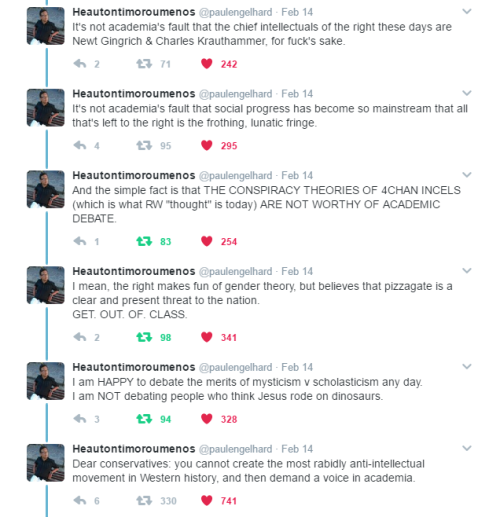Hatesquash - GenX-Rage

More Posts from Hatesquash and Others

Wikipedia’s editors have voted to declare the Anti-Defamation League “generally unreliable” on the Israeli-Palestinian conflict, adding it to a list of banned and partially banned sources. An overwhelming majority of editors involved in the debate about the ADL also voted to deem the organization unreliable on the topic of antisemitism, its core focus. A formal declaration on that count is expected next. The decision about Israel-related citations, made last week, means that one of the most prominent and longstanding Jewish advocacy groups in the United States — and one historically seen as the leading U.S. authority on antisemitism — is now grouped together with the National Inquirer, Newsmax, and Occupy Democrats as a source of propaganda or misinformation in the eyes of the online encyclopedia. Moreover, in a near consensus, dozens of Wikipedia editors involved in the discussion said they believe the ADL should not be cited for factual information on antisemitism as well because it acts primarily as a pro-Israel organization and tends to label legitimate criticism of Israel as antisemitism.

Imagine pouring millions into Hasbara for decades just to lose the information war this fucking badly lmaooo
Anyway, plugging my masterlist of Palestinian media and sources again:

Gardening Info *Long Read*

MORE FAMILIES ARE PLANTING FOOD FORESTS
If you’ve ever wandered back roads in a developing, tropical country, you know that many of the locals grow much of their own food. You might also have noticed that their food gardens aren’t comprised entirely of small annual vegetables planted in straight rows like ours are. They are typically wild-looking plantings of edible trees, shrubs, vines, and ground covers all mingling effortlessly together, as if Mother Nature had planted the garden according to her own design. These are literally forests of food.
Forest gardening has been the standard for millennia in many tropical regions, but it’s possible in more temperate climes as well. A British chap by the name of Robert Hart first popularized the concept among European and North American gardeners with the publication of his book Forest Gardening: Cultivating an Edible Landscape in the 1980s. Food forests have also figured prominently in the permaculture movement, an approach to designing agricultural systems that mimic natural ecosystems.
Why Food Forests?
Food forests are like the ultimate organic garden. Does a forest need tilling, weeding, fertilizer, or irrigation? Nope. And that’s the goal.
Because they’re mostly perennial crops, there’s no need to till. Not tilling preserves the natural soil structure, preventing the loss of topsoil and allowing all the little microbes and soil critters to do their jobs, cycling nutrients and maintaining fertility. The deep roots of trees and shrubs make them much more drought tolerant than annual vegetables, and they shade the smaller plants below, keeping everything lush and moist in a self-maintaining—in other words, a highly sustainable—system.
Step 1: CHOOSE PLANTS
The first step in establishing a food forest is to choose your plants. The largest plants will reach into the sun, so most common fruiting trees and shrubs are fair game. The smaller plants generally need to be more shade tolerant, as they will be in the under story. But you can leave sunny patches here and there—like little forest clearings—to accommodate species that need more light (though see Step 3 for a trick to make the most of the available sunlight).
Winter is the ideal time to get started, because most edible trees, shrubs, vines, and herbaceous plants can be purchased and planted while dormant, which is better for the plants—and for your bank account. That’s because at this time of year they are sold in “bare root” form—meaning without soil or a pot—which gives the roots a more natural structure and costs less for nurseries to produce. Bare root plants are typically ordered in January or February, for planting in early March, or as soon as the ground thaws in your area. Naturally, you’ll want to stick with species that are well-adapted to your region.
CANOPY: This layer is primarily for large nut trees that require full sun throughout the day, such as pecans, walnuts, and chestnuts, all of which mature to a height of 50 feet or more.
UNDER STORY TREES: This layer is for smaller nut trees, like filberts, and the majority of fruit trees. The most shade tolerant fruit trees include native North American species like black mulberry, American persimmon and pawpaw, though many other fruit trees will produce a respectable crop in partial shade.
Vines: Grapes, kiwis, and passion fruit are the most well-known edible vines, though there are many other more obscure specimens to consider, some of which are quite shade tolerant, such as akebia (edible fruit), chayote (a perennial squash), and groundnuts (perennial root crop). Kolomitka kiwi, a close relative of the fuzzy kiwis found in supermarkets, is among the most shade-tolerant vines.
SHRUBS: A large number of fruiting shrubs thrive in partial shade, including gooseberries, currants, service berries, huckleberry, elderberry, aronia, and honey berry, along with the “super foods” sea berry and goji. Blackberry and Blueberry bushes will work well here in the U.S.
HERBACEOUS PLANTS: This category includes not only plants commonly thought of as herbs—rosemary, thyme, oregano, lavender, mint and sage are a few of the top perennial culinary herbs to consider for your forest garden—but is a catch-all term for all leafy plants that go dormant below ground in winter and re-sprout from their roots in spring. This layer is where perennial vegetables, like artichokes, rhubarb, asparagus and “tree collards” fit in.
GROUND COVERS: These are perennial plants that spread horizontally to colonize the ground plane. Edible examples include alpine strawberries (a shade tolerant delicacy), sorrel (a French salad green), nasturtiums (has edible flowers and leaves), and watercress (requires wet soil), all of which tolerate part shade.
RHIZOSPERE: This refers to root crops. It’s a bit misleading to call it a separate layer, since the top portion of a root crop may be a vine, shrub, ground cover or herb, but it’s Hart’s way of reminding us to consider the food-producing potential of every possible ecological niche. Most common root crops are sun-loving annuals, however so you’ll have to look to more obscure species, such as the fabled Andean root vegetables oca, ulluco, yacon, and mashua, for shade-tolerant varieties.
Step 2: PREPARE THE GROUND
Choose an open, sunny location for your forest garden. It can be as small as 100 square feet—a single fruit tree and an assortment of understory plants—or multiple acres. At the larger, commercial-scale end of the spectrum, forest gardening is often referred to as agroforestry. A number of tropical crops, including coffee and chocolate, are grown commercially in this way, though commercial agroforestry is uncommon in North America (other than in the context of timber plantations).
Unlike preparing for a conventional vegetable garden, there is no need to till the earth and form it into beds in preparation for a forest garden. Instead, dig a hole for each individual plant, just as if you were planting ornamental shrubs and trees. However, if the soil quality is poor, you may wish to “top-dress” the entire planting area with several inches of compost prior to planting.
One situation in which raised beds are desirable in a food forest is where drainage is poor. But rather than make the effort to construct conventional raised beds from wood, you may opt to sculpt the earth into low, broad mounds at the location of each tree. Smaller plants may then be positioned along the slopes of the mounds. A variation on this approach is to sculpt the earth into long linear “swales,” which consist of a raised berm (to provide a well-drained planting location) and a broad, shallow ditch (to collect rainwater runoff and force it to percolate into the soil beneath the planting berm).
You will need to eliminate any weeds, grass or other existing vegetation prior to planting. This can be done manually, or by smothering them under a “sheet mulch,” a permaculture tactic in which sheets of cardboard are overlaid with several inches of mulch on top of the vegetation, starving the plants for light and causing them to compost in place. Compost may be added as a layer between the cardboard and the mulch to add extra nutrients. Permaculturists often employ sheet mulching in conjunction with swales to enhance the area prior to planting.
When you’re ready to plant, simply brush aside the mulch and cut holes in the cardboard just big enough to dig a planting hole at the location of each plant. Then slide the mulch back around the newly installed plant. Maintaining a deep mulch is the key to preventing weeds, conserving soil moisture and boosting organic matter—all things that will help your food forest be self-maintaining and self-sufficient
.
Step 3: PLANT
The next step is to arrange your plants in the landscape. Position the tallest species (i.e. the ‘canopy’ plants) at the northern end of the planting area, with progressively smaller plants toward the southern end. This way the taller plants will cast less shade on the smaller ones, especially at the beginning and end of the growing season when the days are shorter and the sun hangs lower in the sky.
Of course, truly shade tolerant plants may be interspersed throughout the understory of the forest garden. You might even consider cultivating mushrooms in the shadiest zones once the large trees have matured. Edible vines may be planted on any accessible fences, arbors, or walls, and you can also train vines up trees, just like Mother Nature does—just be sure the tree is significantly larger than the vine to avoid the tree getting smothered.
The edges of the food forest are suitable for sun-loving annual vegetables, if you wish to include them. Also, keep in mind that it takes decades for large tree to reach their mature size, so in the early years of a food forest there is ample sunlight. Plant sun-loving species in the open spaces between trees and then replace them with more shade-tolerant plants as the forest matures.
BDS added this section to their boycott page and I think people really need to read it:

please remember, pushing unorganized boycotts without carefully fact-checking every company in the list can be actively HARMFUL to the boycott movement.


vetted fundraisers from today. please keep sharing and donating as you're able, it really does so much; even if your individual action feels small, you are helping to save lives.
june 29th:
14-year-old Hala El-Hissi, her two siblings (the younger of whom needs hepatitis treatment), and their mother (€8,459/€16,000) - @halaelhissi, @nadasaftawi, verified by @/sar-soor
Muhammad Al-Azayza and his family, including two children, one with Down syndrome (kr6,738 SEK/kr200,000 SEK) - @hamouda-az, verified by @/sayruq
Ahmed Ziad, his siblings, and their sick parents (£2,733/£30,000) - @ahmed-ziad, verified by @/nabulsi
Basel Ayyad and his family of eight, including his daughter who needs urgent treatment to preserve her eyesight (CHF1,506/CHF60,000) - @basel-1995, verified by @/sayruq
Safaa Abd, her husband, and their two young children (€952/€50,000) - @safaabed, verified by @/90-ghost
Wafaa Alnhal's family of 15, including four children and a newborn (€20,277/€50,000) - @wafs-posts, verified by @/nabulsi
Alaa Al Khateeb's family of six, including her mother who needs medical treatment (£25,391/£56,000) - @alaaalkhateeb, #99 on @/nabulsi and @/el-shab-hussein's spreadsheet
Haneen Atya's family of ten, including several young children, a newborn, and her mother who needs urgent treatment for a stroke and bleeding ($38,011 AUD/$70,000 AUD) - @haneenatya34, verified by @/el-shab-hussein
Mohammed Okal's evacuation and education (kr3,228 NOK/kr90,000 NOK) - @mohammedokal-2, verified by @/90-ghost
Mohammed Adly Haboub and his family of four (he turns 20 today) (kr14,191 SEK/kr300,000 SEK) - @mohammedhaboub, verified by @/90-ghost
Siraj Abudayeh, his wife, and their three young children who've lost their treasured home ($1,398 CAD/$82,000 CAD) - @siraj2024, verified by @/nabulsi
Hadeel Adnan Abu Nasser and her family of 12 (they lost her father in a bombing and her brother to malnutrition; Hadeel is responsible for all her family) (€1,126/€20,000) - @hadeelgaza, verified by @/90-ghost
not yet vetted:
Reem Mohamed, her husband, and their two young children (€1,925/€20,000) - @rem096
i know you likely see posts like this every day, but please don't tune them out. every one of these families and individuals deserves to live safely and pursue their dreams. any contribution you make keeps someone's bright future alive

I can’t mention a city in Sudan to my dad (to give him updates) without him remembering a massacre of our people and then naming off people he personally knew including children that were killed. Like gathered at gun point, doused in gasoline then burned alive. Civilians.…
— sai (@sighahh) March 8, 2024

ive been seeing a new wave of transmedicalists lately I think we gotta start being vocal again about how nasty they are. you don't need to take hormones or have surgery to be a trans person. changing your name and pronouns is gender affirming care. wearing new clothes and hair and makeup is part of transitioning too. you dont need to pass to be trans, you don't need to be male or female.
nonbinary, agender, genderfluid, genderqueer people are trans too if that's a label they want to use for themselves. and anyone who says otherwise is a piece of shit. it's not "anti-transitioning" to say so, it's anti-telling other people what to do with their bodies. it's pro-minding your own fucking business and letting people do what they want with their gender and treating them with compassion and enthusiasm
To reiterate: Christopher Paolini, author of Eragon and other such books, blocked me on Twitter for calling him out about his AI-generated cover.
Tor has admitted he approved this cover and they have been consulting him every step of the way. He is complicit.
It’s honestly so fucking frustrating that this is going to go forward. That the cover to Fractal Noise is gonna be published with AI art that has ripped off other artists. And neither the author nor the publisher give one flying fuck about it.
I don’t think a lot of people really understand what this means. Book cover art is already nearly universally shitty. You go look at fantasy art covers, and they’re all photomanipulations, generally a single girl on the cover doing magic or looking into the distance. There’s no variety. But at least people get paid for them.
With AI art, artists don’t get paid. You know who does? The people who made the dataset. The people who sold the “cover.” Even though it took less than 20 minutes to make.
If this isn’t infuriating you, I don’t know what the hell else to say. Machine learning is coming for everyone’s jobs, and corporate wallets don’t care if it’s safe or not. Certain areas are already experimenting with AI Amazon deliveries, and it’s been hinted that long-haul trucking is next.
This is unacceptable. PLEASE. I’m not going to guilt you into sharing this, but it is CRITICAL that we take a stand now and STOP THIS FROM HAPPENING. If you follow me, I am asking you as a friend to share this, and to find it in your heart to put pressure on people who publish AI art without paying artists.
Tor could change the cover. They’re not, because they’re using Fractal Noise as a test run to see if they can get away with it. Don’t let them. I don’t care how much you like Paolini’s work (although I think Eragon was a boring slog, so I had no qualms about calling him out), you HAVE to do your best to make this stop.
Woke up, chose violence




This thread is amazing.
-
 xcreaseproofx liked this · 7 months ago
xcreaseproofx liked this · 7 months ago -
 left-handed-leftist liked this · 8 months ago
left-handed-leftist liked this · 8 months ago -
 belaythatbeluga liked this · 8 months ago
belaythatbeluga liked this · 8 months ago -
 bennystaxx liked this · 8 months ago
bennystaxx liked this · 8 months ago -
 urlocalmisanthrope liked this · 8 months ago
urlocalmisanthrope liked this · 8 months ago -
 liftingtovalhalla liked this · 8 months ago
liftingtovalhalla liked this · 8 months ago -
 bht-of-tardis reblogged this · 8 months ago
bht-of-tardis reblogged this · 8 months ago -
 hatesquash reblogged this · 8 months ago
hatesquash reblogged this · 8 months ago -
 hatesquash liked this · 8 months ago
hatesquash liked this · 8 months ago -
 blackhillsanitarium liked this · 8 months ago
blackhillsanitarium liked this · 8 months ago -
 mildly-hallucinogenic-toreador liked this · 8 months ago
mildly-hallucinogenic-toreador liked this · 8 months ago -
 no-gods-no-masters-tshirts reblogged this · 8 months ago
no-gods-no-masters-tshirts reblogged this · 8 months ago
